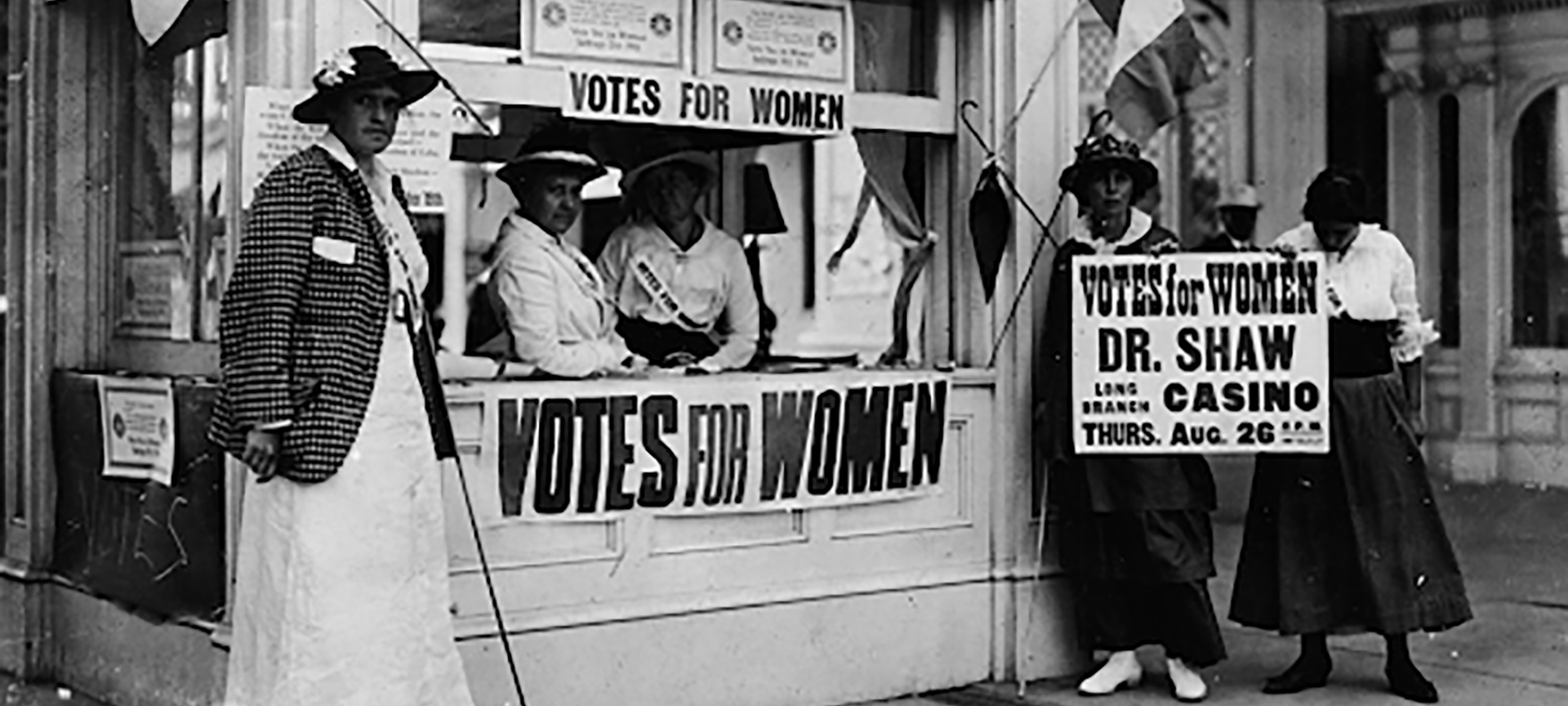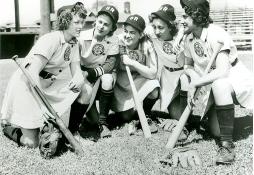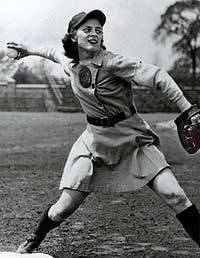1. World War II & Women in Baseball
After completing this or multiple sections of this lesson plan, please take 5 minutes to complete the survey at the bottom of this page. Your feedback will be extremely valuable for future curriculum updates and additions.
Motivational Activity
Show students the photographs below and ask the questions that follow.
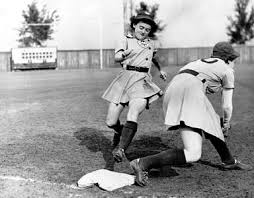
An AAGPBL player rounds third base
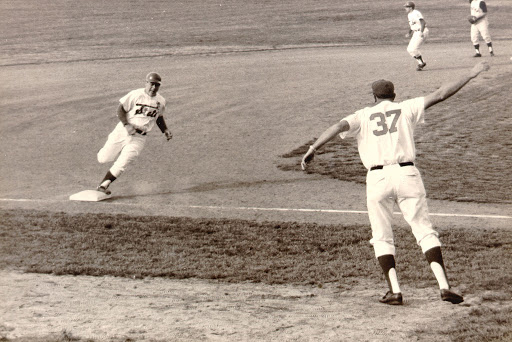
An unknown Cardinals player rounds third base, heading for home
Questions for Students:
- What sport is being played in each of the images below, baseball or softball?
- What specifically led you to your conclusion?
To the teacher: Explain to students that if they guessed that the women in the photograph on the left were playing softball and the men in the photograph on the right were playing baseball, their answers make sense. To support this, tell the class that recently, both softball and baseball were featured sports in the Summer Olympics, softball played as a female sport and baseball as a male sport. However—and perhaps surprisingly—in the images above, baseball is the sport being played in BOTH photographs.
Once you have discussed the above questions as a class, have students watch the following clip, which features sports writer and commentator Kavitha Davidson. After viewing, ask the students to consider, as a group, the questions that follow.
Questions for Students:
- Kavitha Davidson says she is “wary of placing a lot of recognition on softball as a sport.” How does she explain this position?
- In Davidson’s view, in what ways did softball affect the history of women’s baseball?
- What “myths” support the promotion of softball as a sport better suited for women than baseball?
Part 1A:
Let the class know that the image on the left from the Motivational Activity, taken in the early 1940s, is from an All-American Girls Professional Baseball League (AAGPBL) game. In that time period, over six hundred women were playing professional baseball . . . in front of nearly a million spectators each year. Show students the images below to further illustrate that special period in baseball history. As a class, answer the questions that follow:
Questions for Students:
- Can you think of any reason why women’s baseball might have been popular in the early 1940s?
- Do you think there’s a connection between the rise of women’s baseball and U.S. involvement in World War II?
- What was happening in United States history in that period?
To the teacher: U.S. involvement in World War II extended from 1941 to 1945.
Part 1B:
Show the clip from Ken Burns’s Baseball series entitled “Baseball and World War II”. Ask students to take notes as the clip plays. Then consider the following questions as a class. (NOTE: This clip is not about women in baseball or women in sports. Rather, it illustrates the period in our nation’s history when thousands of male major and minor league baseball players left the game to fight in World War II, thereby creating a unique opening for women to play.)
Questions for Students:
- Based on what you saw in the clip, do you think the war effort required a lot of people to enlist in the war, whether by personal choice or not? What in the content suggests this was the case?
To the teacher: Let students know that ten percent of the U.S. population went to war.
- Do you think men and women participated equally in the war?
To the teacher: Of the massive number of U.S. citizens enlisted, only three percent were women.
- Do you think women were allowed to engage in combat?
To the teacher: It was illegal for women to enter into combat situations.
- What, in the context of wartime, is a “draft”? Have you witnessed a draft in your lifetime?
- How do you think it affected the U.S. workforce to have so many men drafted into the war effort?
To the teacher: Because a great number of working age males went off to war, there was a substantial hole in the workforce back home.
- What do you think is the connection between wartime enlistment for men and the rise of women’s baseball?
Part 1C:
Show clip #2 from Ken Burns’s Baseball series. Ask students to take notes as the clip plays. Consider the following questions as a class.
IMPORTANT HISTORICAL NOTE:
It should be noted that the narrative for women of color in baseball is very different from that of the white women in the Ken Burns clip. Black female ballplayers were not recruited for the AAGPBL for the same reason Black male players were not allowed to play in the Major Leagues — The Gentleman’s Agreement. In the 1950’s, however, the Negro Leagues experienced diminished audiences as many Black stars left the leagues for the Majors. In order to generate interest and boost ticket sales, Negro Leagues teams hired female players as novel attractions. For example, the Indianapolis Clowns hired Toni Stone to replace Hank Aaron, who had joined MLB’s Boston Braves in 1952. In addition to Stone, two other Black women players had careers in the Negro Leagues: Mamie “Peanut” Johnson and Connie Morgan.
Questions for Students:
- Did the war provide opportunities for female athletes? Why?
- How did women participate in the war effort?
To the teacher: Women had to enter the workplace to cover for the men away at war or assume non-combat jobs within the military.
- World War II was considered a “total war,” which means that the nation mobilized all of its resources to fight the war, giving priority to warfare over non-combatant needs. How do you think the entry of women into the workplace relates to World War II as a total war?
To the teacher: Factories dedicated to the peacetime manufacture of something like automobiles were often used for military purposes in wartime. Those factories needed as many workers as ever. With so many men overseas, women were often added to the workforce.
Part 1D:
Pass out Handout #1 to your students. Ask them to form small groups, look over the Handout and then answer the questions that follow.
Questions for Students:
- After looking at Fig. 1, how do you think the massive number of men enlisted in World War II by 1945 changed the American workforce during that period?
- In Fig. 2, which year shows a significant increase in the percentage of female production workers? Why do you think there was such an increase?
- Looking at Fig. 3, “Rosie the Riveter,” what do you think she was supposed to represent to women during World War II? What appears to be Rosie’s attitude in the picture? What idea of women’s identity is being promoted?
- How was the call to have men enlist in combat related to the call to have women enter the workforce at home?
Lesson Plan Home:
Women in Baseball: Playing Through Change, Changing Through Play
Post-Lesson Survey
Please complete this 5-minute, post-lesson survey. Your feedback will be extremely valuable for future curriculum updates and additions.

